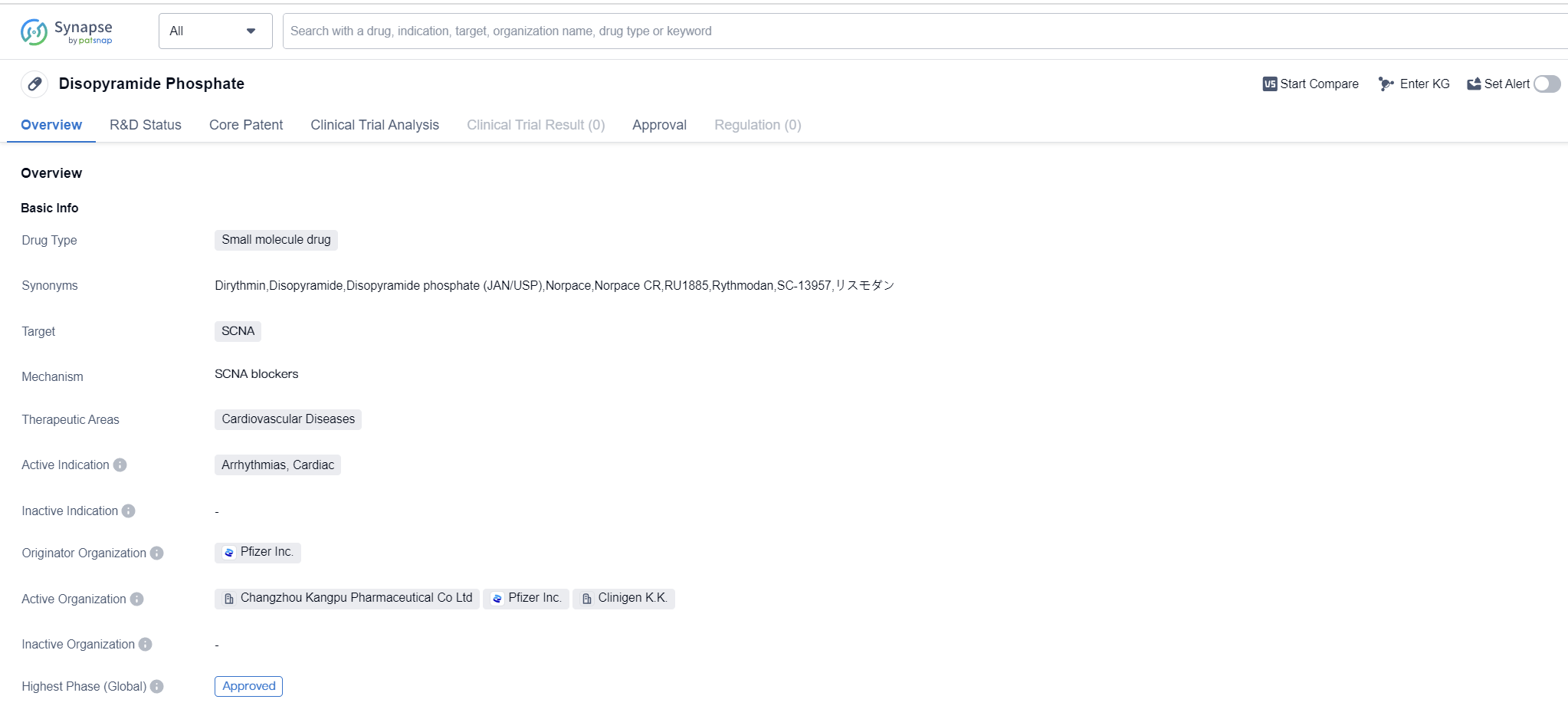Pharmaceutical Insights: disopyramide phosphate's R&D Progress and its Mechanism of Action on Drug Target
Disopyramide phosphate's R&D Progress
Disopyramide Phosphate is a small molecule drug that falls under the therapeutic area of cardiovascular diseases. It specifically targets the SCNA protein and is primarily used for the treatment of arrhythmias and cardiac conditions. The drug was first approved in the United States in September 1977 and is still in use today.
Disopyramide Phosphate is developed and marketed by Pfizer Inc., a renowned pharmaceutical company. It is important to note that the drug has reached the highest phase of development which is approved globally.
Arrhythmias, or irregular heart rhythms, can be life-threatening if left untreated. Disopyramide Phosphate works by blocking certain electrical signals in the heart, helping to restore a normal rhythm. This makes it a valuable treatment option for patients suffering from various cardiac conditions.
The drug's approval in 1977 highlights its long-standing presence in the market, indicating its efficacy and safety profile. Over the years, Disopyramide Phosphate has likely undergone extensive clinical trials and studies to establish its effectiveness and safety in treating arrhythmias.
Given that Disopyramide Phosphate has reached the highest phase of development which is approved globally. This suggests that the drug has a well-established track record and is considered a reliable treatment option for arrhythmias and cardiac conditions.
👇Please click on the image below to directly access the latest data (R&D Status | Core Patent | Clinical Trial | Approval status in Global countries) of this drug.
Mechanism of Action for disopyramide phosphate: SCNA blockers
SCNA blockers are a type of drug that work by blocking the activity of sodium channels in the body. Sodium channels are proteins that play a crucial role in the generation and propagation of electrical signals in cells, including nerve cells. By blocking sodium channels, SCNA blockers can interfere with the transmission of electrical signals, which can have various effects depending on the specific context.
In a biomedical perspective, SCNA blockers are often used in the treatment of certain medical conditions such as epilepsy and cardiac arrhythmias. By blocking sodium channels, these drugs can help reduce abnormal electrical activity in the brain or heart, thereby preventing seizures or irregular heart rhythms.
It's important to note that SCNA blockers can have potential side effects and interactions with other medications, so they should only be used under the supervision of a healthcare professional.
Drug Target R&D Trends for disopyramide phosphate
SCNAs, or Sodium Channel Navs, play a crucial role in the human body by facilitating the movement of sodium ions across cell membranes. These channels are responsible for generating and propagating electrical signals in various tissues, including the brain, heart, and muscles. By controlling the flow of sodium ions, SCNAs regulate the excitability and function of cells, enabling processes such as nerve transmission, muscle contraction, and cardiac rhythm. Dysregulation or mutations in SCNAs can lead to various disorders, including epilepsy, cardiac arrhythmias, and muscle disorders. Understanding the role of SCNAs is essential for developing targeted therapies and drugs to treat these conditions.
According to Patsnap Synapse, as of 12 Sep 2023, there are a total of 252 SCNA drugs worldwide, from 367 organizations, covering 214 indications, and conducting 7657 clinical trials.
The analysis of the target SCNA from various perspectives provides valuable insights into the current competitive landscape and future development. Novartis AG and Pfizer Inc. are the companies growing fastest under the target SCNA, with Novartis AG leading in terms of approved drugs. Anesthesia, Arrhythmias, Cardiac, and Pain are the most common indications for drugs targeting SCNA. Small molecule drugs dominate the drug types progressing rapidly, with biosimilars indicating intense competition. China, the United States, and Japan are the leading countries in drug development for SCNA, with China showing significant progress. Overall, the target SCNA presents a competitive landscape with diverse drug types and indications, and promising future development opportunities.
👇Please click on the picture link below for free registration or log in directly if you have a freemium account, you can browse the latest research progress on drugs, indications, organizations, clinical trials, clinical results, and drug patents related to this target
Conclusion
In summary, Disopyramide Phosphate is a small molecule drug developed by Pfizer Inc. It targets the SCNA protein and is primarily used for the treatment of arrhythmias and cardiac conditions. With its first approval in the United States in 1977, the drug has gained global recognition and has also been approved in China. Its long-standing presence in the market and highest phase of approval indicate its efficacy and safety in treating cardiovascular diseases.






